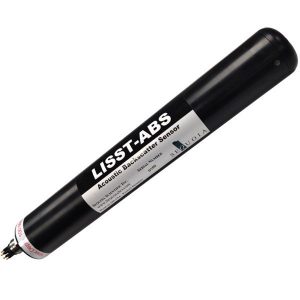Sequoia LISST-ABS X2 Integration Guide
The Sequoia LISST-ABS Acoustic Sediment Sensor is designed specifically for measuring suspended sediment concentrations at a single point. The LISST-ABS is compatible with NexSens X-Series data loggers using the SDI-12 communication protocol and sensor interface. A pre-defined script on X-Series data loggers is able to detect, log, and transmit all parameters from the sensor. Parameter data is transmitted, in real-time, at a user-specified interval (e.g., 10 minutes) to the NexSens WQData LIVE Web Datacenter. There, data is stored on customizable dashboards with statistics and graphical interfaces for each parameter. Users can download and send data reports via Email, FTP, or an API. Below is information on the settings and wiring required to integrate these sensors with a NexSens X-Series data logger.

Figure 1: Sequoia LISST-ABS Acoustic Sediment Sensor integration with NexSens X-Series data loggers.
Compatible Models
Sequoia Scientific’s LISST-ABS Turbidity Sensor is a single-point acoustic sediment sensor. The sensor initially measures Attenuation Corrected Backscatter that is then converted with an internal multiplier to a Suspended Particles (mg/L) measurement.
LISST-ABS Sensor Integration
A pre-defined script on NexSens X-Series data loggers will automatically detect a Sequoia LISST-ABS sensor. The only setting that must be adjusted is the SDI-12 address if another SDI-12 sensor is connected to the data logger.
1. Configure Communication
For the X2 data logger, the SDI-12 communication protocol and the unique address of the sensor are the most important settings. If another sensor on the X2 communicates via the SDI-12 protocol, each sensor must have its own unique SDI-12 address.
- Using an external controller with an SDI-12 terminal communication, enter the following command to change the sensors unique SDI-12 address:
- Syntax: aAb!
- a is the current sensor address.
- A is the change address command.
- b is the new address of the sensor.
- ! terminates the command.
- Example:
- 0A1!
- Requests that the sensor changes its SDI-12 address from 0 to 1.
- 0A1!
- Response
- b<CR><LF>
- b is the new sensor address and <CR><LF> terminates the response.
- b<CR><LF>
- Syntax: aAb!
2. Automatic Sensor Detection
After adjusting the internal communication settings, the sensors and their parameters can be programmed onto the logger via automatic detection.
X-Series Script Information
The X2 data logger includes a pre-loaded Sequoia LISST-ABS turbidity sensor script that will detect the unique SDI-12 address of the sensor, along with the X2 sensor port in which it is connected. Use the CONNECT software to enable the script for sensor detection.
| X2 Script Number | Communication Protocol | Baud Rate | Power Type | Warmup Period (Sec) | Frame |
| 2009 | SDI-12 | 1200 | Switch | 10 | E71 |
The Sequoia LISST-ABS turbidity sensor outputs a single Suspended Particle (mg/L) parameter. The sensor utilizes acoustic backscatter to measure the concentrations of particles suspended in the water. Its initial “Uncalibrated Concentration” is based on measurements from 75-90 micron glass microspheres; however, users can adjust the calibration using a solution with known composition and size of particles. This solution should be a representative sample of the particle sizes expected in-situ.
Sequoia recommends that the LISST-ABS collects a 30-second or longer average. The X-Series data logger utilizes the SDI-12 command M3 to provide a 120-second average (1Hz), providing reliable results over that time frame.
Read Sensor Configuration – Confirm Sensor Detection
After ~5-10 minutes, read the sensor configuration to confirm the sensors have been detected on the data logger. Thoroughly review the parameter list to ensure all parameters are accounted for and are measured in the desired units. Let the unit gather a few readings to confirm accurate and reasonable parameter data.
3. Setting up WQData LIVE
Once an X-Series data logger has finished a new sensor detection, it will automatically push the sensor configuration to the WQData LIVE Web Datacenter. Follow the three articles below to create a WQData LIVE account and a project/site. Then add the data logger to the project using the included claim code.
- Create a WQData LIVE Account
- Create a Project on WQData LIVE
- Add a Data Logger to a Project on WQData LIVE
Real-Time System Application
Real-time turbidity measurements from the Sequoia LISST-ABS Acoustic Sediment Sensor are useful in various environmental monitoring applications.
Applicable Systems
Discover applicable uses for the Sequoia LISST-ABS Acoustic Sediment Sensor.
- Turbidity Monitoring During Construction Operations
- Turbidity Monitoring During Dredging Operations
- Stream and River Monitoring Systems
Case Studies
Read about specific applications using the Sequoia LISST-ABS sensor.
Turbidity Measurements
Learn more about turbidity measurements on the NexSens Blog Page.
- How to Measure Turbidity
- Turbidity Monitoring at Dredge Sites
- Using a Turbidity Buoy at Dredge Sites
- Why Monitor Turbidity for Dredge Projects
Sensor Manual
For more information, refer to the Sequoia Scientific LISST-ABS Turbidity Sensor User’s Manual.

